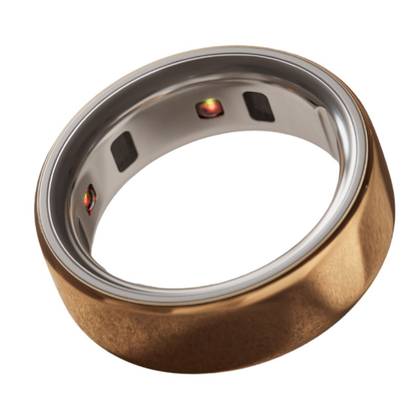A beautiful new Oura Ring 4 Ceramic is on my finger, replacing a titanium Oura Ring 4, which replaced an Oura Ring Generation 3 before it.
It means I’m able to give you an idea which version is the best buy, and whether an upgrade is worthwhile.
Here’s my experience with the most recent Oura Ring releases.
What’s the ceramic version like?
Smooth and shiny
The Oura Ring 4 Ceramic was announced at the beginning of October, and the only change between it and the standard Oura Ring 4 is the material used for its outer skin.
Instead of titanium, it uses zirconia ceramic, and it comes in four new colors — Midnight, Cloud, Tide, and Petal.
I chose the Midnight version, which is somewhere between dark blue and black, making it the stealthiest color option in the new range.
However, darker colors can be more noticeable on your finger, and it’s more noticeable than my choice of Brushed Silver for the Oura Ring 4.
The surface is smooth and warm, with a lovely curve at the sides, separating it from the sharper edge of the titanium Oura Ring 4.
It’s minutely wider than the titanium version, but the difference is minimal when you put it on. I got used to feeling it a tiny bit more between my fingers after a few hours.
The ceramic version still has an indentation on the underside, which is there to get the orientation right on your finger (the Oura Ring 4 series is less prone to sensor issues due to its orientation than the third generation), but it’s shallower and a little less obvious.
If, like me, you locate it with your thumb to put the ring into the correct position at night, it’s easier to miss than the indentation on the titanium model.
The final thing to note is that the ceramic is warmer and “stickier” than the titanium, meaning you notice the ring more often between your fingers. Not in a negative way, though, and it’s something you’ll probably get used to the more you wear it.
Size, fit, and wear
Small differences can add up
I selected the size 11 Oura Ring Ceramic, which matches the size I’ve worn since the second-generation Oura Ring. The ceramic model fits in exactly the same way as the titanium Oura Ring 4.
When I first put on the Oura Ring 4 from the third-generation Oura Ring, I noticed a slight difference in how it fit and felt, and wondered if the smart ring’s sizing was a tiny bit larger than before.
After trying the size 10 version from the fitting kit (using the sizing kit is an essential initial step at the beginning of Oura Ring ownership), it was clear I couldn’t wear the size down.
The Oura Ring 4 is a complete departure from the Oura Ring Gen 3 in design, and those coming from it will immediately notice the change on their fingers, which can result in questioning the sizing.
The Oura Ring 4 has a completely flat underside, without the nubbins found on the third-generation model, and it also has slightly different dimensions.
You will notice it more on your finger, and because of the smooth inner section, it may move around more, or feel less secure during your first few weeks or even months until you’re used to it.
I know I’ve said you’ll notice it, and have talked about some size differences, but it’s worth noting that the size, weight, and style alterations are all minute.
The Oura Ring, regardless of the model, is supremely comfortable to wear, and I’ve had one on for 24 hours a day for about four years now.
This should reassure you that it’s easily one of the most comfortable pieces of wearable tech you can buy.
What about durability?
Expect scratches and scuffs
Unfortunately, it’s really difficult to keep any Oura Ring looking showroom-fresh, purely due to its location on your body.
What’s worse, the scuffs and scratches will appear really quickly, as the smart ring comes into daily contact with different metals and abrasive surfaces.
There is some good news, though, as these scuffs aren’t all that noticeable to other people, and most of the time it’s only you who will see them, and only on close examination.
My Polished Silver Oura Ring Gen 3 and Brushed Silver Oura Ring 4 both picked up the same amount of scuffs over around a year of wearing them, and the surfaces don’t look quite as lustrous as they did on arrival.
However, neither surface looks awful, and I don’t think anyone else would spot the marks.
I’ve only worn the Oura Ring 4 Ceramic for a day or so, and it’s still brand new. I’m resigned to the fact it won’t stay this way, and do fear a little for the beautiful, polished surface with its deep shine.
Oura will send you a special polishing cloth for the ceramic ring, which it says will remove some small scuffs. I’ll test it out when scuffs appear.
The only thing I noticed while photographing the smart ring is that it’s very good at picking up oily smudges from your skin and fingers.
In turn, these are a bit of a pain to clean because it seems to take more than a quick wipe to remove them.
Any performance differences?
Different sensors
If you have an Oura Ring Gen 3 and are wondering whether an upgrade to either of the Oura Ring 4 versions is worth it, there are a few differences to know, outside of the design changes mentioned above.
The Oura Ring 4 has upgraded sensors that allow it to better measure heart rate and blood oxygen, almost regardless of how it’s positioned on your finger.
This is achieved using both hardware and software, and allows the smart ring to function better on all skin types and regardless of gender.
It makes the Oura Ring 4 more consistent with its data, which is noticeable in your overnight heart rate and every day step count, with data from the Oura Ring 4 showing fewer outliers and more believable daily activity levels.
The app experience is identical on both smart rings, and you aren’t getting any additional features with the Oura Ring 4, just improved accuracy.
Battery life is fairly similar, too. I get about five days from the Oura Ring 4, which is perhaps about a day more than I’d get on a single charge from the Oura Ring Gen 3.
My charging tip for the Oura Ring (and smart rings in general) is to put the ring on its charging plinth when you get ready in the morning, as even a 15-minute charge every day or every other day keeps it from ever requiring a full charge.
I almost never think about the Oura Ring’s battery.
Is the Oura Ring Ceramic the one to buy?
Don’t ignore the Gen 3
I’ll start here with the statement that the Oura Ring, in general, is the smart ring to buy.
Yes, it has a monthly $6 subscription, but the app is the best out there, the hardware is superb, and the after-sales support is excellent. It’s one of the few subscription services I think is worth paying for.
Don’t dismiss the Oura Ring Gen 3, even if it’s not the latest model. It’s still available new, and often at a far lower price than the Oura Ring 4.
It’s not quite as technically impressive, but all the same features are there, and if you’re new to wearable tech, a lower initial investment could make sense as you establish whether you want to commit to one long-term.
However, if you’re ready for a smart ring, and plan to continue using it, and want the most accurate data possible, the Oura Ring 4 is the better buy as it won’t need replacing for years.
Which Oura Ring 4 to choose
Still a hard decision
Whether you go for a titanium or a ceramic Oura Ring 4 will be a purely aesthetically driven decision, as there are no feature differences between them.
Just don’t expect it to make the decision any easier, and I’m finding it hard to know which I’d pick when faced with the two together.
The ceramic version’s curvy surface is different from the titanium version’s flat design, and actually far closer to the Oura Ring Gen 3’s shape.
The Midnight color looks stunning in person. It has a deep, lustrous shine that’s almost liquid-like in the right light.
It took me a while to warm to the titanium model’s flatness, but I’ve instantly fallen for the ceramic model’s look.
The Oura Ring 4 Ceramic gives the overall range more versatility, with the brighter colors and shinier finish likely to appeal to different people than the titanium version.
The titanium ring has a look more associated with luxury jewelry, though.
I think you’ll love either one, which is a testament to Oura’s design choices.
The titanium Oura Ring 4 starts at $349, while the ceramic version costs more, at $500. Both are available to buy now.
Oura Ring 4
- Heart rate monitor
-
Yes
- Notification support
-
No
- Battery life
-
Up to 8 days
- Sensors
-
Heart rate/HRV; blood oxygen; skin temperature; accelerometer
- Water Resistance
-
Water-resistant to 100 m
- Ring sizing
-
4 – 15













… [Trackback]
[…] Find More to that Topic: geeksforgeeks.org/is-the-oura-ring-4-ceramic-worth-buying-i-ve-worn-it-to-find-out/ […]